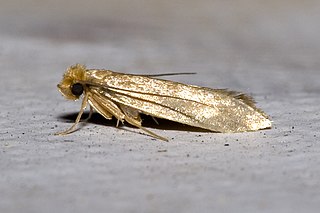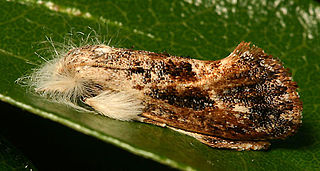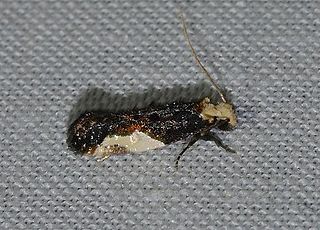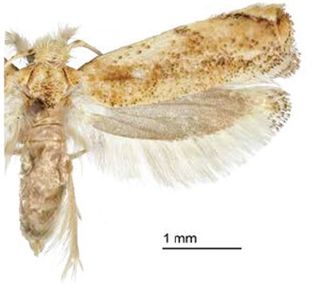Related Research Articles

Tineidae is a family of moths in the order Lepidoptera described by Pierre André Latreille in 1810. Collectively, they are known as fungus moths or tineid moths. The family contains considerably more than 3,000 species in more than 300 genera. Most of the tineid moths are small or medium-sized, with wings held roofwise over the body when at rest. They are particularly common in the Palaearctic, but many occur elsewhere, and some are found very widely as introduced species.

Tineoidea is the ditrysian superfamily of around 4000 moths species including clothes moths, carpet moths, bagworms and relatives. There are five families usually included within it, Eriocottidae, Dryadaulidae, Meessiidae, Tineidae and Psychidae, whose systematics are still under‐studied.

Acrolophidae is a family of moths in the order Lepidoptera. The family comprises the burrowing webworm moths and tube moths. The family holds about 300 species in five genera, which occur in the wild only in the New World. It is closely related to the Tineidae family.

Monopis imella is a moth of the family Tineidae found in Europe.

Monopis monachella is a moth of the family Tineidae. It is widespread in Eurasia, Africa, India, Sri Lanka, Burma, Sumatra, Java, the Philippines, Taiwan, Japan, New Guinea, Samoa, North America and South America.

Nemapogon is a genus of the fungus moth family, Tineidae. Therein, it belongs to the subfamily Nemapogoninae. As evident by its name, it is the type genus of its subfamily.

Pyloetis is a moth genus, belonging to the family Tineidae. It consists of only one species, Pyloetis mimosae, which is found in Asia, including Japan and Taiwan.

Tinea trinotella is a species of tineoid moth. It belongs to the fungus moth family (Tineidae), and therein to the nominate subfamily Tineinae. It was once used as type species of a distinct genus Acedes, but this is synonymized today with Tinea, the type genus of Tineinae, Tineidae and the superfamily Tineoidea.
Praeacedes is a monotypic moth genus in the family Tineidae first described by Hans Georg Amsel in 1954. Its only species, Praeacedes atomosella, was first described by Francis Walker in 1863. It has a wide range and has been recorded from Europe, Australia, Hawaii, India, Malaysia, Solomon Islands, Rapa, Mauritius, Madagascar, Réunion, South America and North America. The species has commonly been misidentified in various parts of the world.

Monopis crocicapitella, the pale-backed clothes moth, is a moth of the family Tineidae described by James Brackenridge Clemens in 1859. It has a nearly cosmopolitan distribution. It was first described from the eastern United States. It is particularly destructive of fabric and clothes. A study undertaken on eleven English Heritage properties over several years before the winter of 2017-2018, showed that the number of moths captured in traps increased significantly during the study period.

Niditinea striolella, the brindled clothes moth, is a moth of the family Tineidae. It was described by Shōnen Matsumura in 1931. It is found from most of Europe to Japan.
Archinemapogon yildizae is a moth of the family Tineidae. It was described by Ahmet Ömer Koçak in 1981. It is found in most of Europe, except Ireland, the Benelux, the Iberian Peninsula and most of the Balkan Peninsula. The habitat consists of birch woodlands.

Haplotinea insectella, the drab clothes moth or fungus grain moth, is a moth of the family Tineidae. It was described by Johan Christian Fabricius in 1794. It is found in all of Europe, except Ireland, the Iberian Peninsula and the western and southern part of the Balkan Peninsula. It is also found in North America. The species is often found in warehouses, granaries, mills and farm buildings.

Nemapogon clematella, the barred white clothes moth, is a moth of the family Tineidae. It is found in most of Europe and in North America, where it has been recorded from Maryland and North Carolina. The habitat consists of woodlands.

Monopis pavlovskii, Pavlovski's monopis moth, is a moth of the family Tineidae. It is found in China, Russia, Japan and Korea and is an introduced species in North America, where it has been recorded from New York to central Florida and west to Michigan. Specimens have also been found as far west as Illinois.
Triaxomera puncticulata is a moth of the family Tineidae. It found in Japan.

The Erechthiinae are a subfamily of moth of the family Tineidae.
Psychoides phaedrospora is a moth of the family Tineidae, first described by Edward Meyrick in 1935. It is found in Japan.
References
| Wikispecies has information related to Liopycnas |
| This Tineidae-related article is a stub. You can help Wikipedia by expanding it. |